Best Microphone Under $100 for Vocal: As we all know about the development in the field of music. Gone are the days when musicians had to work their dash off to get signed by any record label. Today, you can get famous through your song by doing almost everything by yourself. This blog will be about the best microphone under $100 for vocals.
There are many streaming services available that provide you with the best opportunity to show your talent to the whole world. Many of the new generation artists record their songs at home and use those platforms to build their own audience.
There are various types of mics under $100 that you can get if you are finding the best microphone under $100 for vocals. Although these days, there is a great shift towards USB microphones. This is because musicians want to set up their studio on a minimal budget. Buying the USB mic under 100 will cost them less cutting the+ price of the Audio Interface.
Let me tell you a thing, you can get the best price-cut in buying the USB microphones, but using an XLR mic will give you better quality. So you have both options to choose from. Either you can go with the budget, or you can choose the quality. Now as I said you have to compromise with the quality, It doesn’t mean that USB mics are not preferable. It’s just that you get the quality more in XLR mics in comparison to the USB ones.
You’ll learn everything in this blog. So don’t worry about which will be the best for you.

CREATE MIX YOU CAN FEEL PROUD OF
If You Want To Mix Your Music Like Professionals,
You Have To Learn From Professionals And We Have Made It EASY For You.
Introduction
The idea of recording music and producing it all by yourself can be very monotonous sometimes. And it can reach higher if you are on a tight budget. That’s why today I’ve brought to you the list of the top 10 best affordable microphones under $100.
The microphones given on the list doesn’t only are less in the budget, but also good in the quality-wise. Many artists use these microphones for vocal recording and are streaming the songs on various online platforms.
Today, in this blog, you are going to see some of the best microphones under $100. So sit tight, and follow me till the end.
Our Quick Top Pics
If you are in a Hurry, Here I’m mentioning our Top 5 best microphones for vocal Under $100. These are our top pics. You can directly go for them as they are the best in the range and provide the best value for money.
1. Audio Technica AT2020 – (Our Best Choice in Condenser Microphone)
2. AKG P120 – (Our Second Best Choice in Condenser Microphone )
3. MXL 990 – (3rd Best Choice in Condenser Microphone )
4. Shure SM58 – (Our Best Choice in Dynamic Microphone )
5.sE Electronics V7 – (Our Second Best Choice in Dynamic Microphone )
But before entering into the list directly, there are certain things that you need to consider or you should know about. There are various things that you should know of like, What are Condenser Mics, What are Dynamic Mics, How to use them, etc. These questions will be answered at the end. But before that, you should know the difference between Condenser Microphones and Dynamic Microphones.
Let’s Start the Journey of getting deeper in finding the Best Microphones for Vocals under $100.
Types Of Microphones
Before entering the battle of the Dynamic microphone and condenser microphone, let’s learn about the types of microphones that are actually available in the market. If you are looking for the best mics under $100 for yourself, it’s compulsory to know about other types of microphones too.
Let’s take a look at the different types of microphones that you must know and when are they used.
1. Carbon Microphones
You must have seen this type of microphone in the old movies. Carbon microphone is the oldest and most simple microphone that was used for recording in the olden days.
It has a thin coating of either metal or plastic diaphragm on one side. When hit by the soundwaves, the carbon dust gets compressed and changes its resistance. Later due to the flow of the current, the frequency of the sound gets changed.
And this is how the recording in the olden ways was done. But today, Carbon microphones are only used as some kind of props and not for vocal recordings.
2. Ribbon Microphone
Ribbon Mics are bidirectional meaning the sound can be captured from both sides. In the ribbon microphones, a thin ribbon is made of aluminum, duralluinium, or nanofilm. When the soundwaves enter, the ribbon vibrates within its magnetic field. The vibration generates the tiny voltage as per the velocity.
The ribbon microphone has a really thin and delicate element because of which, the voice captured is very fast. These microphones are very sensitive and fragile to use. Therefore, it’s always needed to handle with care.
3. Cardioid Microphones
If you want to record a mic from only a single direction, Or need a microphone that doesn’t record with the other side as well, you can go for Cardioid Microphones. They are unidirectional. That means these mics record from only a single side.
The polar Pattern of Cardioid Microphone is considered as the following type.
- Unidirectional
- Kidney
- Heart
The best benefit of using this type of microphone is its unidirectional feature. You won’t be recording any extra choir from the other side.
4. Dynamic Microphones
We come to the second most famous variant of the microphones. Dynamic Microphones are very famous among the music community people.
Dynamic microphones convert the sound into an electrical signal through the process called electromagnetism. The process takes place in two types of mics, they are ribbon microphones that we saw earlier and the other one is moving coil i.e our very own, Condenser Microphone.
We are going to learn more in detail below. So let’s just move to our next type of microphone in the list.
Read More about Dynamic Microphone: Best Budget Dynamic Microphone
5. Condenser Microphones
Condenser Microphones are also called ‘Capacitor Microphones’ by the British because of the structure of the microphone. You may have learned this in your classroom about the capacitor. “The capacitor is two metal plates placed nearby, the closer the metals, the higher the capacitance.
Using this technology, the condenser microphones were made. While dynamic microphones are mostly used for live performances because of their tough body, condenser microphones are used in studios.
They are too sensitive in nature when it comes to capturing sound.
Read More about Dynamic Microphone: Best Budget Condenser Microphone
Dynamic vs Condenser Mics
When it comes to choosing a microphone for your home studio, it’s always better to know what do you need. You can not use the condenser mics for the live shows, and similarly, using the dynamic microphone can be sometimes done, but that requires some factors to keep in mind.
Dynamic Microphone
As I already told you, the dynamic mics do work in the mechanism called electromagnetism. This makes the microphone capture the voice closest to it and excludes the rest.
Because of the low range of catching the vocal frequency, dynamic mics are mostly used by singers for live shows. They catch the voice of the person who is closest to it and it helps to give the clean vocals that are needed rather than capturing other unwanted noise.
What are dynamic microphones used for?
If you are a singer and you do a lot of choir in your neighborhood, you can use these dynamic microphones. Imagine during the live shows, there is a large crowd cheering for you while you are singing. And your microphone catches the crowd cheer too, it won’t sound soothing, isn’t it? Dynamic microphone do this work for you and only records the voice of a person closest to it.
Also, for musicians who play guitar or drums, this mic helps them a lot as sometimes they may hit the microphone with their hands or stick unwillingly. The mics being tough in nature, can absorb all kinds of toughness.
So the Dynamic Microphones are used for live shows and for the musicians who play drums or guitar.
Can you use a dynamic mic to record vocals?
Mostly. Condenser Microphones are used for recording vocals. But under some circumstances, dynamic mics are also used for recording vocals. Let me tell you how and when can you use dynamic microphones to record vocals.
Suppose you have a home studio, and the room in which you’ve set up the studio doesn’t have proper sound-proofing, or padding to absorb the sound, then you are definitely going to face the problem of echo in your vocals. While using a condenser mic for recording in such rooms, your echo will get recorded too and it will create a problem in mixing.
But the dynamic mics are made in such a way that they record the vocals which are nearest to it. So the echoes do not get recorded.
This doesn’t mean that you can record a good voice in a full echoed room with a dynamic microphone. Sound padding is necessary to absorb the echoes and get a clean voice to record.
Why do you need dynamic michrophone?
We need a dynamic microphone because it gives us a clear voice while playing any instrument or singing live. Also because of the toughness of the mic, it can be used at any type of place without any bothering about defecting the microphone.
As I already mentioned above the use of dynamic microphones let me tell you again. Dynamic microphones are used in the Iive performances and while playing the instruments like Guitar, drums, etc.
How close should you be to a dynamic microphone?
The voice capturing capacity of the dynamic microphones is quite less than that of the condenser microphones. So you need to be closer to the microphone to record good quality vocals.
The best position between your mouth and your mic (Dynamic microphone) should be around 6-12 inches. This will give the mic to catch your sound more effectively without receiving any extra unnecessary vocals.
Condenser Microphone
Condenser Microphones are the most sensitive microphones in comparison to any of the others. Even a little amount of shake in the surrounding can result to waste in your recording.
While recording the vocal or any instruments, the mic (Condenser Microphone) is placed on the stand and the shock absorber mount. The stand keeps away the microphone from touching and the shock mount prevents any kind of movement of the mic.
One needs to be very careful with the condenser microphones while recording.
What are condenser microphones best for?
The condenser microphones are best for only recording vocals and instruments. These mics are used only in the studios under some modifications.

CREATE MIX YOU CAN FEEL PROUD OF
If You Want To Mix Your Music Like Professionals,
You Have To Learn From Professionals And We Have Made It EASY For You.
A condenser microphone is very sensitive and has the ability to record every sound present in the room. Proper soundproofing is done to use the condenser mics. If you want to use this microphone as your home studio setup, keep in your mind that you have a room that does not have an echo or any other surround sound.
Are condenser mics louder than dynamic?
Because a condenser microphone catches more sound frequency than that of a dynamic microphone, doesn’t mean it’s louder.
The only reason condenser microphones are considered louder ones is because of their sensitivity. They are much sensitive than dynamic ones. Whereas, the type of mic should be chosen according to the requirements.
So NO, Condenser Mics are not Louder than the dynamic Microphones. And to conclude, No mics are either louder or softer, it all depends upon the sensitivity of the mics.
How close should you be to a Condenser microphone?
The condenser microphones have high sensitivity record every detail of the vocals. Even the sound from very far can be recorded by it.
While singers or instrument players are recording through a condenser mic, they need to keep in mind to keep a proper distance between themselves and the microphone as even a small shake can spoil the recordings.
Again you can keep a safe distance of 6-12 inches between your mouth and microphone. But always remember to use the pop filters while recording through the condenser microphone. This will help to prevent the ‘ph’ sound that comes from your mouth.
Advantages of Dynamic Microphone
1. Cheap
When it comes to the price tag between the condenser mics and dynamic mics, dynamic always wins. They come in a range of prices starting with very cheap prices.
If you looking for recording microphones for a home studio, and instead require one just to use for choir or small gatherings, the dynamic microphones are the best options on a budget for you.
2. Tough
One other important reason for using dynamic microphones over the condenser mics is the build quality. Dynamic microphones are very tough in nature and can handle a lot of pressure.
Even if it falls to the ground, you don’t need to worry about it, your microphone will be safe yet. So if you are a traveler, roam to various places, this will be best for you guys.
3. Easy to Use
While using dynamic microphones, you don’t have to be a technical person. The components are basic and easy to use.
Without putting too much effort into understanding the settings of the microphone, you can proceed directly to your performance by just switching the microphone on with a single button.
Advantages of Condenser Microphones
1. Great Range Capture
If you are using the dynamic microphone for recording vocals, you may not get the best quality in comparison to the sound quality you will get from the condenser microphone.
The condenser microphone has a great range to capture the sound that is why you get enhanced quality of vocals recorded through it. To use the condenser mics, you just need to choose a place with minimal sounds and echoes.
2. Frequency
To get a clear voice, a microphone should be able to give the flat frequency response, but it becomes quite difficult for other types of mics to give the flat frequency.
But condenser microphones provide the perfect flatter frequency response which gives a nice-sounding vocal.
3. Great for record Ambience and Effects
Due to its better frequency response and great dynamic range, the condenser microphone suits best for the recording of ambiance sound and sound effects.
You get a clear and soothing sound in comparison to the result of a dynamic microphone.
Which is the best microphone for Singing?
Not only me, actually no one in this world can answer this question in a simple way. The definition of the best is different for each person. So, the answer to the best microphone for singing lies within yourself.
If you have the ability or say talent, you can record the quality sound on a very ground-level priced microphone and vice versa. Under the budget of $100, you’ll get plenty of condensers as well as dynamic mics that can give you an awesome sound quality.
For the beginning phase, every microphone under $100 is the best on the list. You can go with anyone among them.
Why should I go for the $100 Mics?
I mean why not? I know the mics listed below are known as cheap microphones, yet, they are still very much considered to be a budget unit. After looking at the pros of the $100 microphones, you’ll understand that how important these mics are for you and your career.
There are many people who can’t even afford the mics for under $100. Now that doesn’t mean the microphones that you get below $100 are bad. It’s just every microphone has different roles to play while recording.
The best microphone under $100 will give you the best quality sound that you can use to record and stream on the best quality streaming platforms such as Spotify, youtube, and whatnot.
So if you are a beginner and want to experiment with it, Mics under $100 are for you. If you are a professional artist and looking for something best for live shows and recording for youtube, these best microphones under $100 are for you. If you are building a Budget Home Studio Setup, These microphones under $100 are for you.
Will I need an Audio Interface to record with the microphone on the list?
Okay, here we come to the other two types of microphones – XLR Microphones and USB Microphones. So what are the basic differences between the XLR and USB Microphones?
The Difference Between XLR and USB Microphone

Well, the main difference is just in the connectivity. If you’ll choose an XLR Microphone, you’ll require two other gears in order to record any track. The XLR cable comes out from the microphone and is connected to the Audio Interface. Again the audio Interface is connected to your computer. By Audio Interface, I mean the mixer. You cannot connect your XLR microphone directly to your computer.
By going for the USB microphone, you are required to just have the mic and a computer with you. Simply you have to connect your USB microphone to your computer using a USB cable.
Which is better USB or XLR Microphone?
Actually, the answer is really as per one’s personal preference. If you are looking for a microphone for podcasting, USB mics are the best. You don’t need any extra device in between, plus the sound quality for just voice is best. Also, you don’t need to put extra on the budget.
But, if you are looking for a microphone especially for vocal recording, music production, and instrument recordings, I would suggest you go for the XLR mics. They give a better sound quality and are used by professional musicians.
So yes, the option totally depends on your choices and preferences. If you are an artist and looking to buy a mic for music production, Audio Interface is a must.

CREATE MIX YOU CAN FEEL PROUD OF
If You Want To Mix Your Music Like Professionals,
You Have To Learn From Professionals And We Have Made It EASY For You.
Top 10 Best Microphone under $100 for Vocal Recording
Enough of giving the knowledge about the microphone. Let’s dive into the list of 10 Best Microphones for Voice Recording under $100 of a Budget.
| Microphones | Weight | Frequency Response | SPL | Polar Pattern | Buy on Amazon |
|---|---|---|---|---|---|
| Audio Technica ATR2500X – USB | 1.21 lbs | 30 Hz to 15 kHz | 144dB | Cardioid | CHECK PRICE |
| Shure SM 58 | NA | 50Hz-15kHz | 94dB | Cardioid | CHECK PRICE |
| Audio-Technica Ae6100 | 0.68 lbs | 60Hz-15kHz | 130dB | Hypercardioid | CHECK PRICE |
| MXL 990 | 0.68 lbs | 30Hz-20kHz | 133dB | Cardioid | CHECK PRICE |
| sE Electronics V7 | 0.67 lbs | 40Hz-19kHz | NA | Supercardioid | CHECK PRICE |
| Audio Technica AT2020 | 1.44 lbs | 20Hz-20kHz | 144dB | Cardioid | CHECK PRICE |
| AKG P120 | 1.37 lbs | 20Hz-20kHz | 148dB | Cardioid | CHECK PRICE |
| AKG D5 | 1.44 lbs | 70Hz-20kHz | NA | Cardioid | CHECK PRICE |
| Audix OM-2 | 0.68 lbs | 48Hz-19kHz | 144dB | Hypercardioid | CHECK PRICE |
| Neat Microphone Worker Bee | NA | 20 Hz to 20 kHz | 145dB | Cardioid | CHECK PRICE |
Top 10 Best Microphone under $100 for Vocal Recording
Let’s take a closer look at the features and specifications of the mics mentioned above in detail. Although it was quite difficult to find the best microphone under $100 for vocal recording, we’ve found the best out of best. You can choose any among them.
And, here they are…
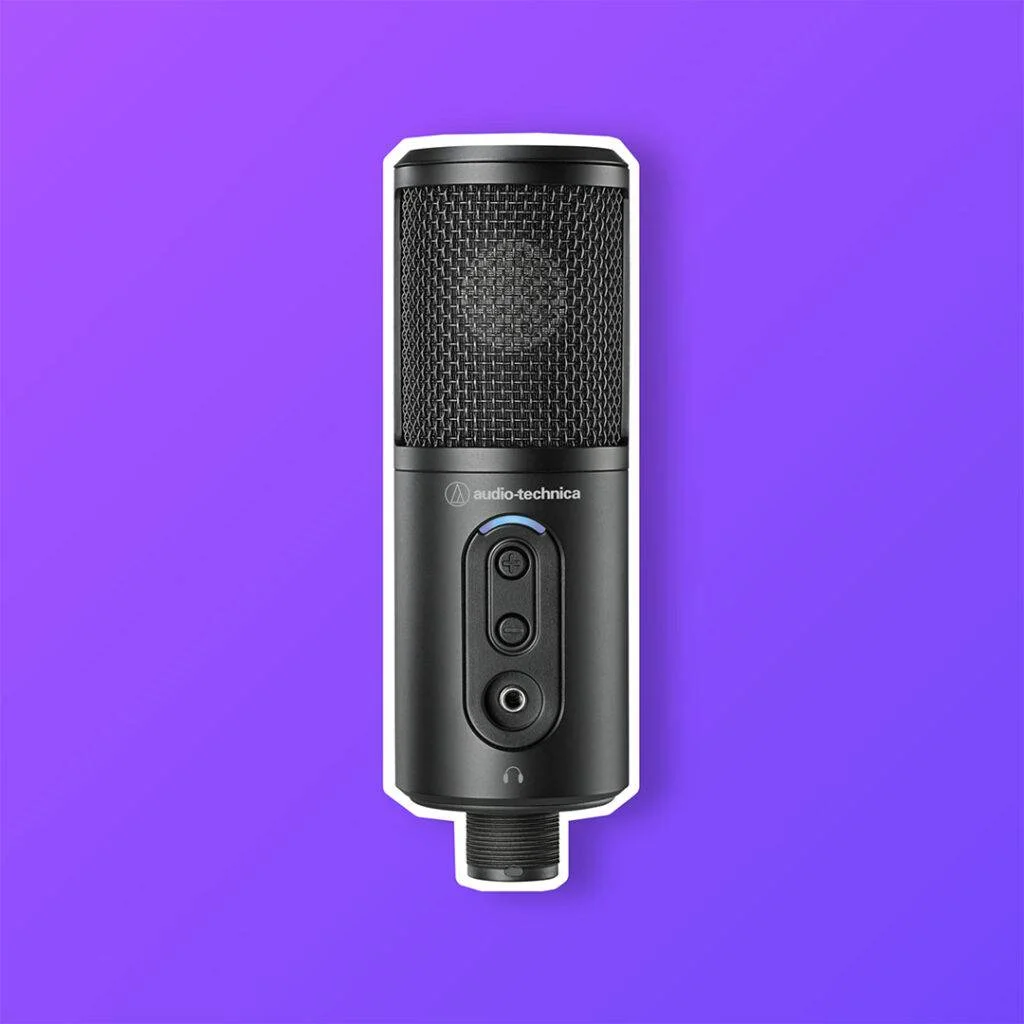
Specifications
| Microphone Type: Condenser | |
| Polar Pattern: Cardioid | |
| Diaphragm Size: 63″ (16mm) | |
| Frequency Response: 20Hz-10kHz | |
| A/D Resolution: 16-bit/48kHz | |
| Max SPL: 144db SPL (1kHz at 1% THD) | |
| Output Impedance: 47 ohms | |
| Signal to Noise Ratio: 74dB, 1kHz at 1Pa | |
| Self Noise: 20dB | |
| Colour: Black | |
| Connector: USB Type B (mic output), 1/8″ TRS (headphones) | |
| Requirements: Mac: OS X 10.8.5 or Later | |
| Requirements:PC: Windows 7 SP1 or Later | |
| Power Source: Bus-powered | |
| Dimensions: 6.38″ x 2.05″ | |
| Weight: 85 lbs | |
| Included Accessories: Tripod Desk Stand, USB Cable, Mic Stand Adapter, Soft Pouch | |
| Manufacturer Part Number: AT2020USB+ |
Pros & Cons
Pros
- Build quality is fairly well
- Long USB cable Type-C
- Low Price
Cons
- Not good as XLR
Discription
atr or Audio Technica ATR 2500x-USB is the first on the list of Best Microphone Under $100 for vocals. First of all, let’s talk about the build quality of this bad boy.
The build quality is actually fairly well, It’s got a nice weight
to it and there’s basically zero plastic on the body itself except for the buttons on the front to change the volume. Unfortunately, though, that can’t really be said about the accessories.
Inside the box, you get a decently long USB type-C to type-A cable, and I actually have no complaints about the cable. it’s a great length, reaches all the way that it needs to for any home studio setup. Well, there is a downstand while music the cable to connect your microphone directly to your computer, or else, it’s just fine.
You also get the microphone stand, desk mount, well not really desk mount
perse’s more just like a little tripod for it.
my personal opinion on this is that if you have the budget, you can go for a different mic stand as the quality isn’t as good as mentioned. You’ve got the direct monitor port on it for your headphones and basically, some shock mounts can cover it up and it can get pretty annoying but anyway let’s talk about the target person for this microphone who’s actually going to buy this bad boy.
Well, the price is actually fairly decent for the Best Microphone Under $100 for vocals. It comes in at just about 30 bucks cheaper than the others. The shock mount of this microphone works just decent. I won’t say that it’s best but also not worst. So yes for the starters, you can go with this microphone blindfolded.
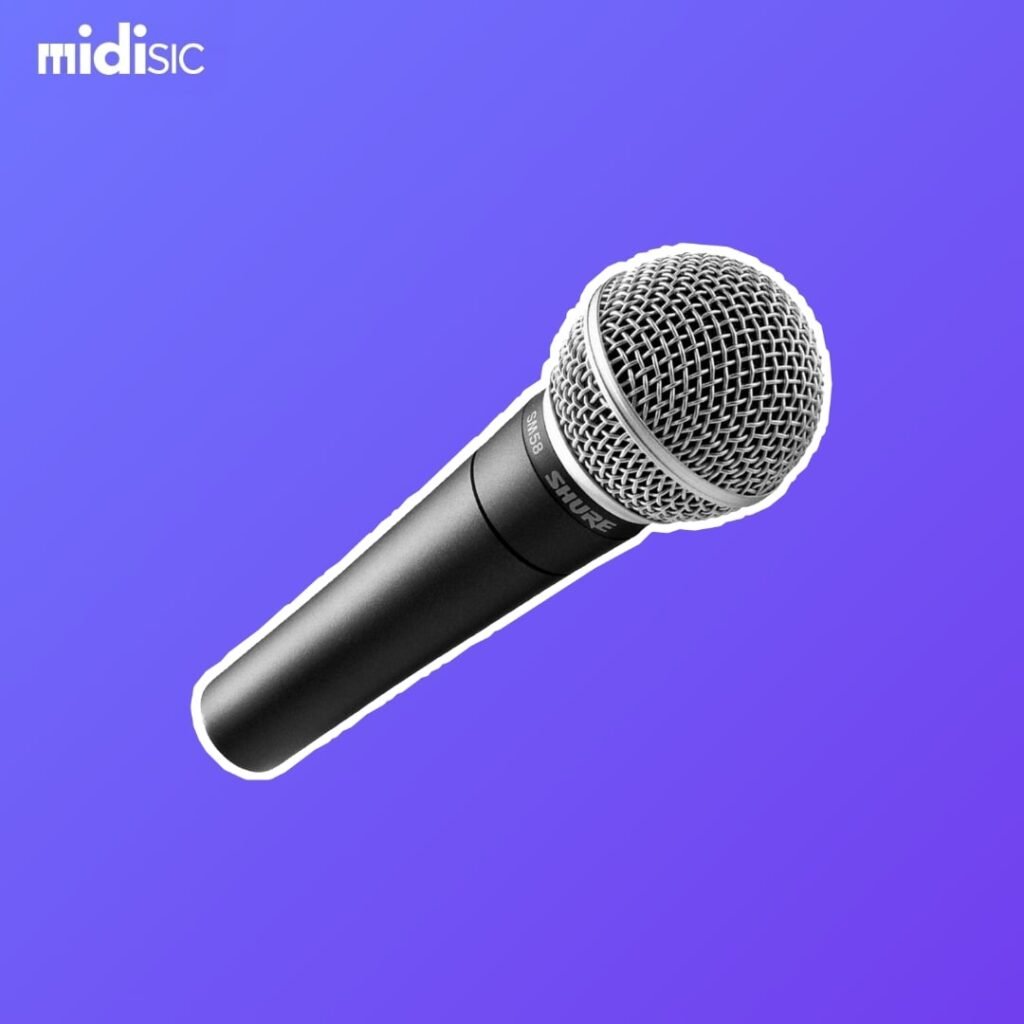
Specifications
| Microphone Type: Dynamic | |
| Polar Pattern: Cardioid | |
| Frequency Response: 50Hz-15kHz | |
| Max SPL: 94db SPL | |
| Colour: Black | |
| Connector: XLR | |
| Power Source: USB Bus-powered | |
| Dimensions: 6.3″ x 2″ | |
| Weight: 0.66 lbs. | |
| Manufacturer Part Number: SM58-LC |
Pros & Cons
Pros
- Cheap and Affordable
- great sound reading
- build quality is good
Cons
- Does not provide Pop filter
- Lacks shock mount
- The self-noise level is quite loud
Discription
We’ve come to our second list of the Best Microphone Under $100 for vocals. If you are into traveling and live shows, you must have definitely come across this dynamic microphone.
If to be honest, this particular microphone is probably the most famous that is considered the Best Microphone Under $100 for vocals. And we are delighted to tell you the one and only reason for the popularity of this undescribable microphone. And that is – IT’S VERSATILITY.
Yes, the versatility of the Shure SM58 is what made it famous among the whole community of Podcasters, Musicians, Youtubers, and the list goes on. This microphone can be used at any stage if you are a singer. In many grand concerts, Sm58 is used. But, this dynamic microphone can only be used for live shows to the performers. If you want to record your song at your home using a microphone, I would recommend going for the best budget Condenser microphone.
Also, this microphone was used during speeches, comedy shows, podcasts, etc. So basically, Shure SM58 is the one-stop for you to buy a dynamic mic if you have a budget of around $200 to $300.

Specifications
| Microphone Type: Dynamic | |
| Polar Pattern: Hypercardioid | |
| Frequency Response: 60Hz-15kHz | |
| Max SPL: 148db SPL | |
| Colour: Black | |
| Connector: XLR | |
| Power Source: USB Bus-powered | |
| Dimensions: NA | |
| Weight: 0.68 lbs. | |
| Manufacturer Part Number: AE6100 |
Pros & Cons
Pros
- The great sound quality stands out from the crowd.
- Provide studio-quality sound
- The difference from other microphones in the range is comparable
Cons
- Some complaint about its long term reliability
- For some, Audio-Technica may feel bland look wise
Discription
Artists who use AE6100 hypercardioid mic are extremely happy about the product and spread positive word of mouth about the same. This Best Microphone Under $100 for vocal delivers clean articulation and assertive sound for uncompromising vocalists.
The microphone comes with a polar pattern that is tailored for an outstanding on-axis response. AE6100 is the dynamic mic that offers maximum feedback rejection as well as superior anti-shock engineering for lower handling noise.
The mics hardened grille is lined with steel mesh and a layer of open-cell foam. This helps the microphone to provide ultimate protection against vocal plosives. At the top of the element, there is a foam disk placed to prevent any pop sound through the mic.
Audio-Technica AE6100 is a mic that has the tendency to have a great presence and sound that cuts through the monitor mixes. If we talk about build quality, then this microphone feels strong in hands and also quite beautiful.
The AE6100 stands head and shoulders among each other. Out of those I named, the only one that can be compared with AE6100 and that is the OM5. The rejection qualities are similar between the two, and the gain seemed to be similar. When I AB’d the OM5 and the 6100 at the local music shop, the 6100 seemed a bit more robust to me.
I would recommend this to pretty much anyone who is a vocalist. I’ve used the exact same mic after trying shure products, Sennheiser, and a few other low ends.

CREATE MIX YOU CAN FEEL PROUD OF
If You Want To Mix Your Music Like Professionals,
You Have To Learn From Professionals And We Have Made It EASY For You.

Specifications
| Microphone Type: Pressure Gradient Condenser | |
| Polar Pattern: Cardioid | |
| Diaphragm Size: 0.78″ (16mm) | |
| Frequency Response: 30Hz-20kHz | |
| A/D Resolution: 16-bit/48kHz | |
| Max SPL: 130db SPL (1kHz at 0.5% THD) | |
| Output Impedance: 200 ohms | |
| Signal to Noise Ratio: 80dB | |
| Self Noise: 20dB | |
| Color: Champagne | |
| Connector: XLR | |
| Requirements: Mac: OS X 10.8.5 or Later | |
| Requirements:PC: Windows 7 SP1 or Later | |
| Power Source: 48V Phantom Power | |
| Dimensions: 5.11″ x 2.36″ | |
| Weight: 1.2 lbs | |
| Included Accessories: Hardshell Case, Mic Stand Adapter, Shock Mount | |
| Manufacturer Part Number: MXL990 |
Pros & Cons
Pros
- Cheap and Affordable
- quality xlr cables
- build quality is good
Cons
- Does not provide Pop filter
- Lacks shock mount
- The self-noise level is quite loud
Discription
The mxl990, you will get the 2 under 150 bucks. Isn’t that cheap? Initially, I used these microphones, bought 2 on an amazon deal, and ever since then, I haven’t grabbed my expensive mics.
Every time I used these microphones, I got another reason to like them even more and wanted to use them. Well, it’s suitable for both, podcasting and singing. Without breaking your bank, you can just buy these budget studio microphones. This is one of the Best Microphone Under $100 for vocals that can come in your budget.
Along with the mic, you will get the XLR cable that you can connect with your audio interface, and from the audio interface, your sound will enter the computer.
For any condenser microphones which isn’t a USB version, you’ll be needed an audio interface. The quality of the mic is very good though you’ll need your room acoustically treated in order to get the perfect voice.
If you are looking for the Best Budget Audio Interface, I would suggest going for the blog – Best Budget Audio Interface.
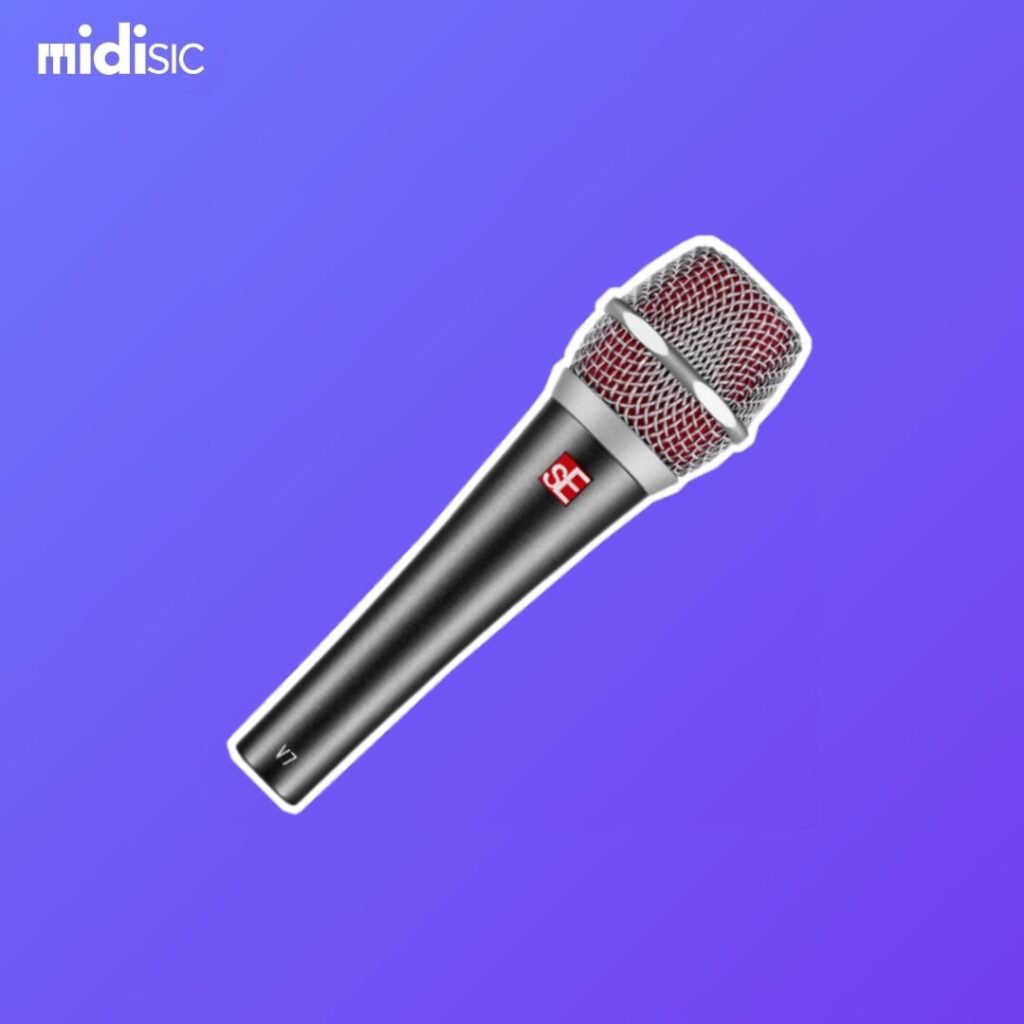
Specifications
| Microphone Type: Dynamic | |
| Polar Pattern: Supercardioid | |
| Frequency Response: 40Hz-19kHz | |
| Max SPL: NA | |
| Colour: Black | |
| Connector: XLR | |
| Power Source: USB Bus-powered | |
| Dimensions: 7.24″ x 2.12″ | |
| Weight: 0.67 lbs. | |
| Manufacturer Part Number: V7-U |
Pros & Cons
Pros
- Great Build Quality
- Solid Vocal Sound
- Fair Price Range
Cons
- Not much
Discription
Here we are to yet another big brand in the microphone department. BUT, let me tell you, sE took a lot of time to build a dynamic microphone. Although they already knew they will have to compete with the already famous Shure SM series, the sE electronics couldn’t hold themselves behind.
So you must have understood how confident sE was with its budget dynamic microphone. Let’s see the reason that made them so sure about the same.
The sE Electronic’s V7 mic has really a solid-feeling metal body. The whole body is colored with a black finish that looks so glossy and clean. The V7 has a silver grille along with a red windshield that refines the overall look of the budget dynamic mic.
The sE’s V7 is a super-cardioid mic that sounds much smoother in comparison to other microphones in the budget. V7 because of its tight pickup patterns, more subtle combinations gives the advantages of noticeably more levels of good quality mics.
There are many people who claim V7 over any Shure’s budget dynamic microphone. This is because this mic offers the best quality in the projection of the voice especially because of its ability to cut through mixes with higher EQs.
If you ask my personal preference, I will suggest to g for this as along with the great sound quality of the microphone, I love the design of the same. So, my recommendation for this mic will be for those who like to choose something that is more popular in the market and has the high ability to provide you with the quality that you are looking for.
Well, this doesn’t come under the list of the Best Microphone Under $100 for vocals but is one of the best microphones for vocal recording.
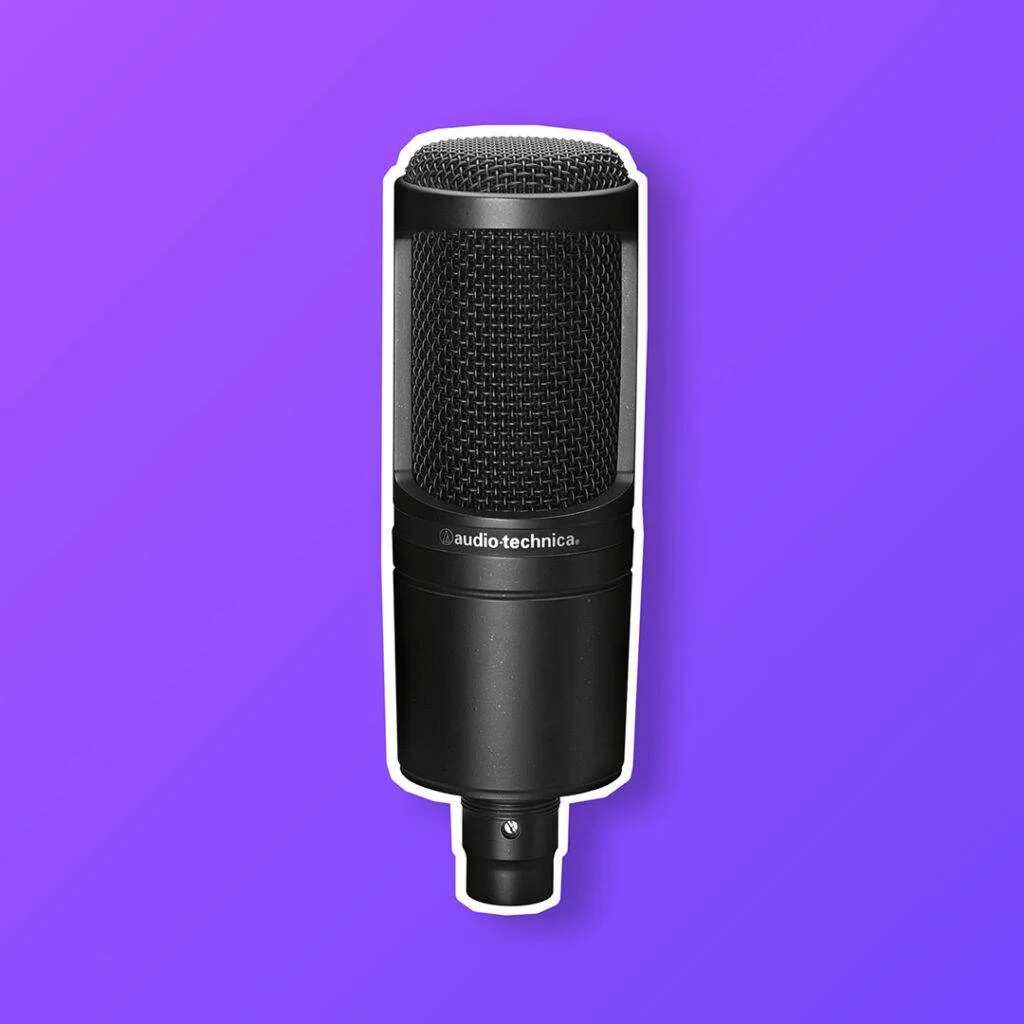
Specifications
| Microphone Type: Condenser | |
| Polar Pattern: Cardioid | |
| Diaphragm Size: 63″ (16mm) | |
| Frequency Response: 20Hz-10kHz | |
| A/D Resolution: 16-bit/48kHz | |
| Max SPL: 144db SPL (1kHz at 1% THD) | |
| Output Impedance: 47 ohms | |
| Signal to Noise Ratio: 74dB, 1kHz at 1Pa | |
| Self Noise: 20dB | |
| Colour: Black | |
| Connector: XLR | |
| Requirements: Mac: OS X 10.8.5 or Later | |
| Requirements:PC: Windows 7 SP1 or Later | |
| Power Source: Bus-powered | |
| Dimensions: 6.38″ x 2.05″ | |
| Weight: 85 lbs | |
| Included Accessories: Tripod Desk Stand, USB Cable, Mic Stand Adapter, Soft Pouch | |
| Manufacturer Part Number: AT2020 |
Pros & Cons
Pros
- Amazing Quality
- Easy to use
- Great build quality
- Good polar pattern
Cons
- To some, the sound was quieter
- Some faced white noise on the recording
- The pack doesn’t include XLR cables
Discription
Audio Technica’s new at2020 is undoubtedly the best studio microphone or we can say the Best Microphone Under $100 for vocals you’ll find in the store. I personally used it in my past and trust me the quality is superb for an entry-level condenser microphone.
The polar pattern of the microphone is a fixed cardioid and you won’t find any switches for pads or filters. Though that won’t be any problem for you. Easier the settings in the beginners level, the better the options.
At2020 is slightly smaller in size if compared to Audio Technica’s other varients, but it does not compromise the quality of the sound. If you think that a small size will decrease the recording quality, you might be wrong. The sound that this mic records is warm and tough solid.
With the bandwidth 20Hz to 20kHz, the at2020 offers plenty of bass extension. You get the deeper recordings.
In terms of build quality, the microphone is made up of solid metals with the outer part covering the inner capsule. The microphone has a second layer outside that helps in a way to cover the popping sound, but in order to reduce it completely, you can always opt for pop filters. That will help to neglect the ‘ph’ sound
At2020 being the vocal microphone gives a mid-range warmth that most singers love. Getting a clean deep voice is what you should look for while searching for microphones. Though there are quite limitations when recording the instruments from a distance.
But if your instruments have a sound that is high, then yes you can maintain a proper distance. İf you are starting your career now, go for it.

CREATE MIX YOU CAN FEEL PROUD OF
If You Want To Mix Your Music Like Professionals,
You Have To Learn From Professionals And We Have Made It EASY For You.
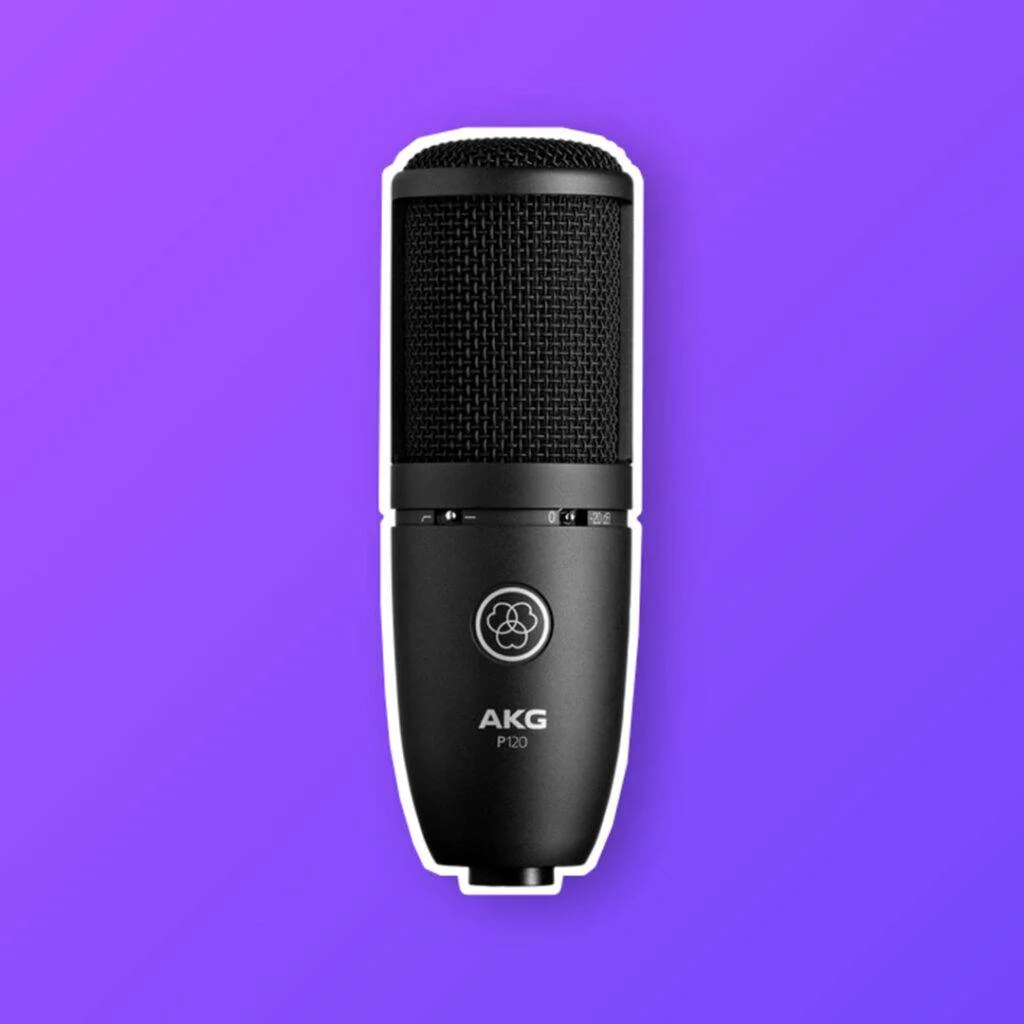
Specifications
| Microphone Type: Condenser | |
| Polar Pattern: Cardioid | |
| Diaphragm Size: 0.66″ (16.39mm) | |
| Frequency Response: 20Hz-20kHz | |
| A/D Resolution: 16-bit/48kHz | |
| Max SPL: 130db SPL | |
| Output Impedance: 200 ohms | |
| Signal to Noise Ratio: 75dB | |
| Self Noise: 19dB | |
| Colour: Black | |
| Connector: XLR | |
| Requirements: Mac: OS X 10.8.5 or Later | |
| Requirements:PC: Windows 7 SP1 or Later | |
| Power Source: Bus-powered | |
| Dimensions: 6.49″ x 2.12″ | |
| Weight: 85 lbs | |
| Included Accessories: Mic Stand Adapter | |
| Manufacturer Part Number: 3101H00400 |
Pros & Cons
Pros
- Cheap and Affordable
- great sound reading
- build quality is good
Cons
- Does not provide Pop filter
- Lacks shock mount
- The self-noise level is quite loud
Discription
AKG P120 is the 7th on the list of the Best Microphone Under $100 for vocals If you’re looking for an entry-level xlr microphone for singing vocals or voiceover, this thing is going to do it all. It’s only $99 and you’re hearing the p120 right now.
The akg p120 is built in a way that should last long enough until you become capable to buy a high price condenser microphone with your own earned money. I hope you are getting what I’m trying to say.
The cardoid polar pattern is used in P120. So, it can be used for multi-mic as the voice coming from other sides will not be caught with microphone being unidirectional.
The great plus point while buying this mic is the lightweight. Being in your hand, you won’t feel any extra weight of metal. This allows for better accuracy of the input.
Since being cheap and affordable in price, akg p120 is best for the home studio. You can use it if you make a song in your bedroom and want to start from the beginning in your learning phase.
If we talk about the downside of the microphone, it doesn’t come with the shock mount. And shock mount is the necessary equipment that you’ll need to protect any vibration during recording sessions.

Specifications
| Microphone Type: Dynamic | |
| Polar Pattern: Supercardioid | |
| Frequency Response: 70Hz-20kHz | |
| Self Noise: 18dB | |
| Colour: Black | |
| Connector: XLR | |
| Power Source: USB Bus-powered | |
| Dimensions: NA | |
| Weight: 1.44 lbs. | |
| Manufacturer Part Number: 3138X00070 |
Pros & Cons
Pros
- Good quality Microphone
- Fair price range
- Value for money
Cons
- Handling can be a little noisy
- Feedback susceptibility
Discription
This is our eighth recommended best microphone for under $100 budget. D5 is a microphone that is light in weight but also sturdy. AKG D5 has a super-cardioid pickup pattern that makes it less prone to the pickup of off-axis sources of the sound.
As we all know, every product has its good as well as bad sides So let’s talk about the drawback that this microphone has. The first drawback is handling noise. This budget dynamic microphone is a little noisy when you use it while holding on to your hands. The next drawback of D5 is that it has a propensity to feedback at a lower frequency than other similar price ranged budget microphones.
AKG D5 has a promising Frequency Response that the brightness is the same as you get on SM58 but without any abrupt bumps in the high end. Also when we talk about the low-end, it’s equally appreciable as the high-end.
AKG has its own patented laminated diaphragm that claims to be less resonant and therefore more resistant to feedback. An integrated pop filter is provided inbuilt. So you don’t need to think a lot about the unwanted ‘ph’ sound popping out while singing or using it live.
The design of this microphone is very simple but if we talk about the build quality, well, it’s a durable one.
So, if you are a musician who is looking for an affordable, adequate-sounding mic, here’s the option for you. Singers who are amateur and new in the music field, you don’t require a high-priced microphone. Instead, go for the budget dynamic microphone that offers you good sound quality.

Specifications
| Microphone Type: Dynamic | |
| Polar Pattern: Hypercardioid | |
| Frequency Response: 48Hz-19kHz | |
| Max SPL: 148db SPL | |
| Colour: Black | |
| Connector: XLR | |
| Power Source: USB Bus-powered | |
| Dimensions: 7.5″ x 2.2″ | |
| Weight: 0.68 lbs. | |
| Manufacturer Part Number: OM5 |
Pros & Cons
Pros
- Gives natural sound
- The vocal definition is really good
- Great resistance to acoustic feedback as well as handling noise
- You also get a 5-Years warranty
Cons
- Well, you don’t get any real cons on this hyper-cardioid microphone, Although, care must be taken while working with the main axis. It’s because the sensitivity drops away quite quickly.
Discription
If you’re looking for a new stage microphone, the best option is to look at the worthy models than the regular ones. Audix OM-5 is not any regular budget dynamic microphone that you will get referred by anyone. But it comes in a range where it gets defined by the word comes ‘Underrated’.
When you think of any Vocal stage microphone, You may not hear ‘Audix’ as the first name. But this company – Based in the USA, is in the market of Microphone business for around 30 years. Their mics are designed, assembled, made, and tested individually at their origin factory. So you don’t need to think a lot about the build and the production quality here at all.
The Audix OM-5 exhibits low handling noise and is the best that will comfort you for handheld use. The tight hypercardioid pattern of the microphone provides a good amount of feedback rejection. Yet, at the rear, they aren’t that sensitive. And because of this, OM-5 is the best option to choose for stage purposes.
When you move close to the mic, there’s a tonal change, and you can notice that change due to the proximity effect. If you move closer to the mic, there are high chances that you may face the poping issue. Again, that’s not a major concern at all. You can always be at a proper gap distance from yourself and your budget dynamic microphone.
As a final point, I just want to write that every mic in the OM series gives excellent results. Whether you are thinking of using it in the studio or for the live concerts, there’s not gonna be a single chance that will allow you to give a complaint about the microphone. So yes if you are the one who likes to try new things, this will be the best option for you to explore yourself and your voice qualities.
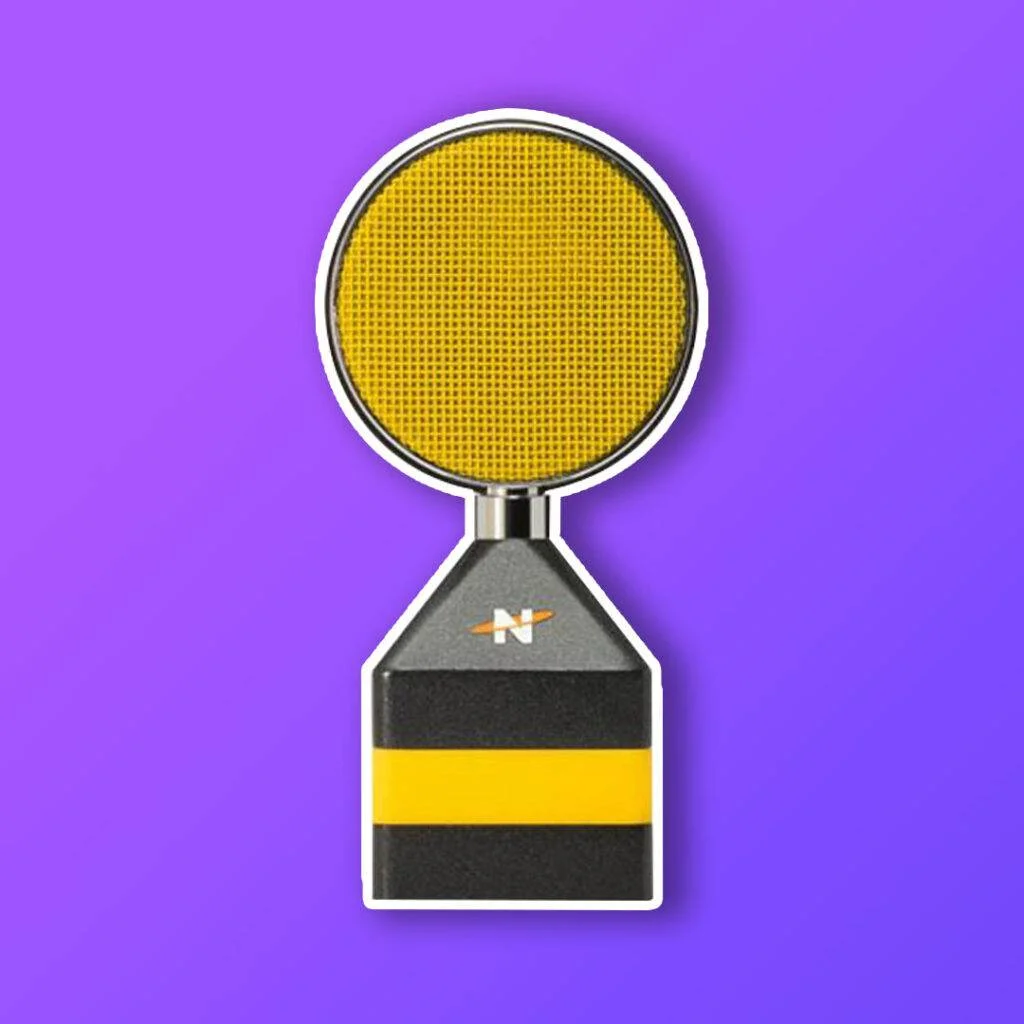
Specifications
| Microphone Type: Condenser | |
| Polar Pattern: Cardioid | |
| Diaphragm Size: 24mm | |
| Frequency Response: 20Hz-20kHz | |
| A/D Resolution: 16-bit/48kHz | |
| Max SPL: 145db SPL | |
| Output Impedance: 50 ohms | |
| Signal to Noise Ratio: 79dB, 1kHz at 1Pa | |
| Self Noise: 9.5 dB | |
| Colour: Black/Yellow | |
| Connector: XLRM | |
| Requirements: Mac: OS X 10.8.5 or Later | |
| Requirements:PC: Windows 7 SP1 or Later | |
| Power Source: Bus-powered | |
| Dimensions: 6.38″ x 2.05″ | |
| Weight: 0.98 lbs | |
| Included Accessories: Pop Filter, Shock Mount | |
| Manufacturer Part Number: MIC- WBCSSC |
Pros & Cons
Pros
- Audio Quality is Top-Notch
- Distinctive Design
- Easy to Set-Up
- Free Spinny Toy
Cons
- Very heavy
- Different design(may not be liked by everyone)
- Have two screws in the bottom.
Discription
We’ve come to our last option for the Best Microphone Under $100 for vocals.
Skipper wise and Martins Saulspurens founded a company named Neat Microphone. This is a new company under the umbrella of Gibson Brands.
There are two variants of the neat bee. The king variant and the worker variant. The king variant is an expensive one and the worker is quite cheap under $100.
The microphone has a large diaphragm of 35mm. The cardioid pick-up is from the side of the mic. The noise to signal ratio is 16Hz to 20kHz what worker bee is promising.
The build quality of the microphone is a tough metal. And the design is of a honeycomb. Well, design-wise, it may not be suitable for everyone, but if you are looking for something of a different design in the market, this will work. Actually, the design is quite good and attractive.
The pop filter of the microphone is what İ like the most. İt pops on the part of the mic where there is a capsule. İf you look underside, you’ll find two screws directly into threaded holes on the microphone and also you’ll find a recess to the base of the shock mount to guide you.
Although it’s of a distinctive design, a catchy one. Once you made up your mind to buy this microphone, you’ll fall in love with the design and its quality.

CREATE MIX YOU CAN FEEL PROUD OF
If You Want To Mix Your Music Like Professionals,
You Have To Learn From Professionals And We Have Made It EASY For You.
Verdict
According to me, If you are looking for the Best Microphone Under $100 for a vocal that is good in all aspects, You should go with Audio Technica at2020. This one is the best microphone in the budget and also let me tell you a thing.
Being a singer myself, when I started my career as a music producer, the first Studio vocal recording microphone that I chose was at2020. And trust me, you will get a quality response.
Things to Consider
If you are looking or planning to buy something new for the first time, make sure that you must always know the things to consider about the product.
There are many things that you need before looking into the microphones for recording Vocals. We have covered everything important below. So read that carefully and be thorough before buying the best microphone under $100 for vocals.
Build Quality
Build quality is what you should look for in the first place when you buy any new products. The material of the product says a lot, whether it’s made of cheap plastic or from a rich fiber.
In microphones, you will get a variety of build qualities. You can also get the best-finished microphone at a cheap price, whereas there are also some which will be high in terms of price, but very low in build quality.
Frequency Response
Most audio products you purchase have a frequency response listed as one of the standard specifications. Frequency responses are available for speakers, headphones, microphones, amplifiers, receivers, CD or DVD players, and any number of other audio devices or components.
Some manufacturers tout having a wide frequency range, but such numbers tell only part of the story and aren’t necessarily an indicator of overall sound quality. A set of headphones may list a frequency response specification of say 34 Hertz to 20 Kilohertz plus or minus 3 decibels, but what exactly does that mean? It indicates that sound between 34 Hertz and 20 Kilohertz is accurate within plus or minus 3 decibels.
I’ll provide you with a detailed explanation of what frequency response is. Just a word of warning; this is a bit of an advanced topic so if you do have questions, leave a comment below and I’ll answer them for you.
What is Frequency in Michrophone?
So, what is frequency response and why does it matter? Frequency response, which is often displayed on a graph or chart as a curve, describes how a device responds to sound across a range of frequencies, Frequencies are measured in Hertz along the x-axis of a graph with sound pressure level measured in Decibels alone on the y-axis of the graph.
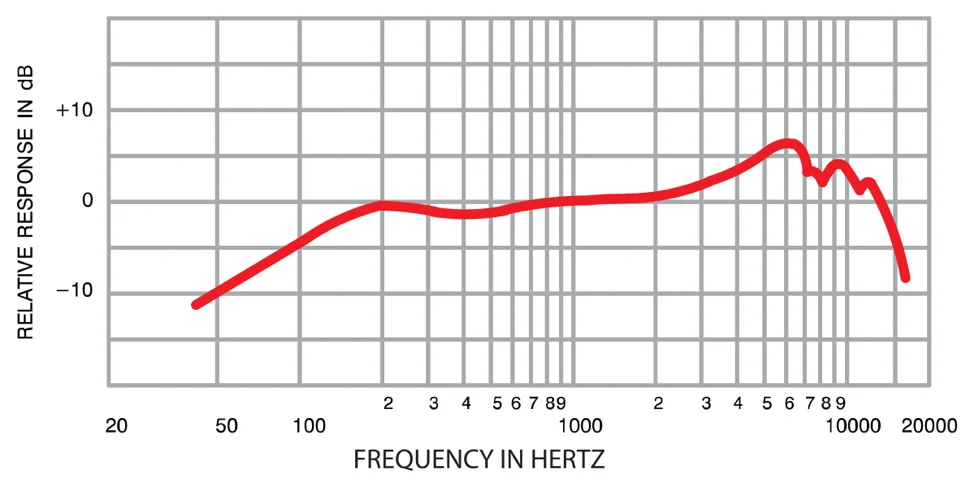
A frequency response curve is a graphical representation of how a microphone will respond in the audio spectrum and so how it will affect the signal’s overall sound timbre. Most products list specifications that cover a minimum of 20 Hertz on the low end to 20Kilohertz on the high end which is the generally accepted hearing range for humans. Frequencies above and below these numbers are often referred to as wideband frequency responses and can also be important. The measurement of decibels indicates the maximum variation of volume level and how well a device remains uniform, from the lowest to the highest tone.
Read More about Frequency Response in Microphone: What is Frequency Response in Microphone
Polar Pattern
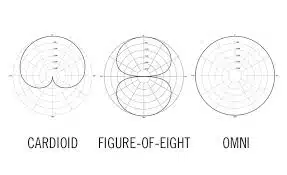
Now let’s talk about the Polar pattern and how well a microphone will pick up sound coming at it from different directions – from the front, from the side, or from the back. Remember some microphones are 360 degrees so where it’s not just the front, there is also the back, its top and the bottom, and just everything.
so essentially, microphones come in two basic polar pattern flavors we have – omnidirectional and unidirectional. Small patterns can pretty much be grouped into those.
Omnidirectional
Omnidirectional is as it sounds. Omni means all-around. So that’s a microphone that will respond to sound equally all around the microphone. So if you have an omnidirectional microphone, You could rotate it in any direction and your voice will not change. That’s an omnidirectional microphone.
Unidirectional
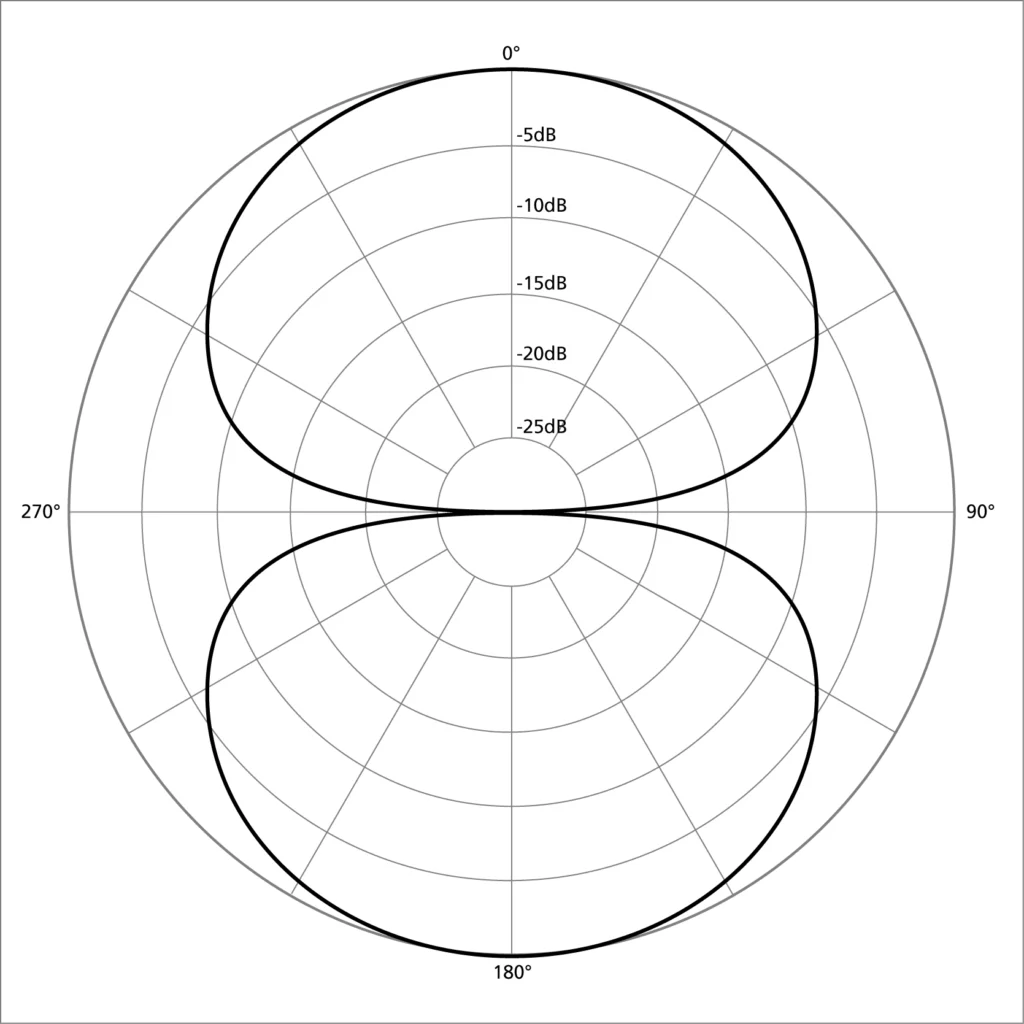
These patterns are bi-directional also known as figure-of-eight. You see there are a lot of studio mics and most ribbon microphones are unidirectional Microphones. These microphones pick up equally well from the front and from the back, but the null point on figure-of-eight microphones is ninety degrees off-axis.
There’s also a subcardioid pattern that has a wider acceptance angle than a cardioid and that can be useful when you’re picking up more than one vocalist maybe in a choir, a group vocal situation. The acceptance angle of a sub-cardioid mic is 170 degrees. Well hopefully, I was able to give you a little bit of information on pickup patterns and why different patterns are there, and hopefully, you’ll be able to make your next mic choice.
Sensitivity
Sensitivity is the level of sound pressure that comes from the speakers. The louder the sound coming after recording from the mic, the higher the sensitivity.
As we all know, condenser microphones are the ones with high sensitivity. If you put two mics on a signal to different mics and then go back and listen to which one’s louder, well the louder one’s more sensitive it’s really simple.
USB
The full form of USB is – “Universal Serial Bus”. With the USB-type microphone, you can connect your microphone directly with your computer. You don’t need any extra audio interface for the purpose of recording your vocals.
This option is great if you want the microphones for your home studio setup. Well, one of the microphones on our list of best budget condenser microphones for vocals is a USB microphone. i.e Audio Technica ATR 2500.
XLR
If you are not looking for the USB version, you may go for the XLR version. So basically what does XLR means is that you connect your microphone with your computer or laptop through an audio interface and the microphone is connected with the audio interface using the XLR cables.
This option is quite expensive than the USB one because the audio quality that you’ll get afterward, in the XLR ones, will be far better than the one with the USB version.
Below I have answered a few frequently asked questions. Please read them If you have any doubt.

CREATE MIX YOU CAN FEEL PROUD OF
If You Want To Mix Your Music Like Professionals,
You Have To Learn From Professionals And We Have Made It EASY For You.
FAQ
While looking for the best microphone, there always comes a budget in between. well, technology has become very advance these days. There are many decent mics that you can get for under $100. According to me, the cheapest good quality microphone that you can go for is the MXL 990. It has some awesome features and also is very cheap when compared with others. You can get the full details in the blog. So you can read it, and just go for it.
There isn’t any particular brand that can be said as they are best. Every brand does its best to bring out the best product of theirs to the musicians. It totally depends on your likings and the priority of what you are going to choose.
Above I’ve listed some of the best brand microphones. You can choose anyone along with them as per your budget. Each of them has its own positive as well as negative points.
If you are a singer or an instrument player, I would suggest you go with any XLR condenser microphones. Blue Yeti is a USB condenser mic. And is best for the podcasts. But for recording the vocals for the track, my recommendation would be to go for the XLR microphones.
The response of a condenser mic is much better than that of other microphones. If you have a studio or produce music at your home, a condenser microphone will be a better option for you to record vocals.
Yes, a Condenser mic is better for vocals
Audio Technica AT2020 Mic.
She and her brother used to use the Audio Technica AT2020 in their initial days to record and produce music.
For most of the recording sessions, Bruce Swedien – Michael Jackson’s audio engineer, used an SM7 mic.
When you are out looking for the best vocal mic for yourself, it becomes extremely difficult to find out the best option for yourself. Well, I would recommend you to know everything that you need in your vocals. If you want the mic for live shows, go with the dynamic ones, but if you are struggling to find the best microphone under $100 in condenser microphone, Just understand the microphone frequency response. Also, don’t forget to read other things you are required to know before buying the best microphone for yourself on the blog – Best Microphone Under $100.
XLR Condenser Microphones.
But, you can also go with the USB microphone as they cut the cost of an audio interface.
A decent condenser microphone does cost you around from $85 to $150. Whereas, you can also go with the dynamic microphone in the same range.
Absolutely you can use a USB mi to record Vocals. There are many artists who use USB microphones in their recording sessions. It’s just if you can extend your budget, XLR mics are suggested. But USB mics also do provide an awesome quality in sound. So if you want to go with the USB mic, you can surely go for it.

CREATE MIX YOU CAN FEEL PROUD OF
If You Want To Mix Your Music Like Professionals,
You Have To Learn From Professionals And We Have Made It EASY For You.

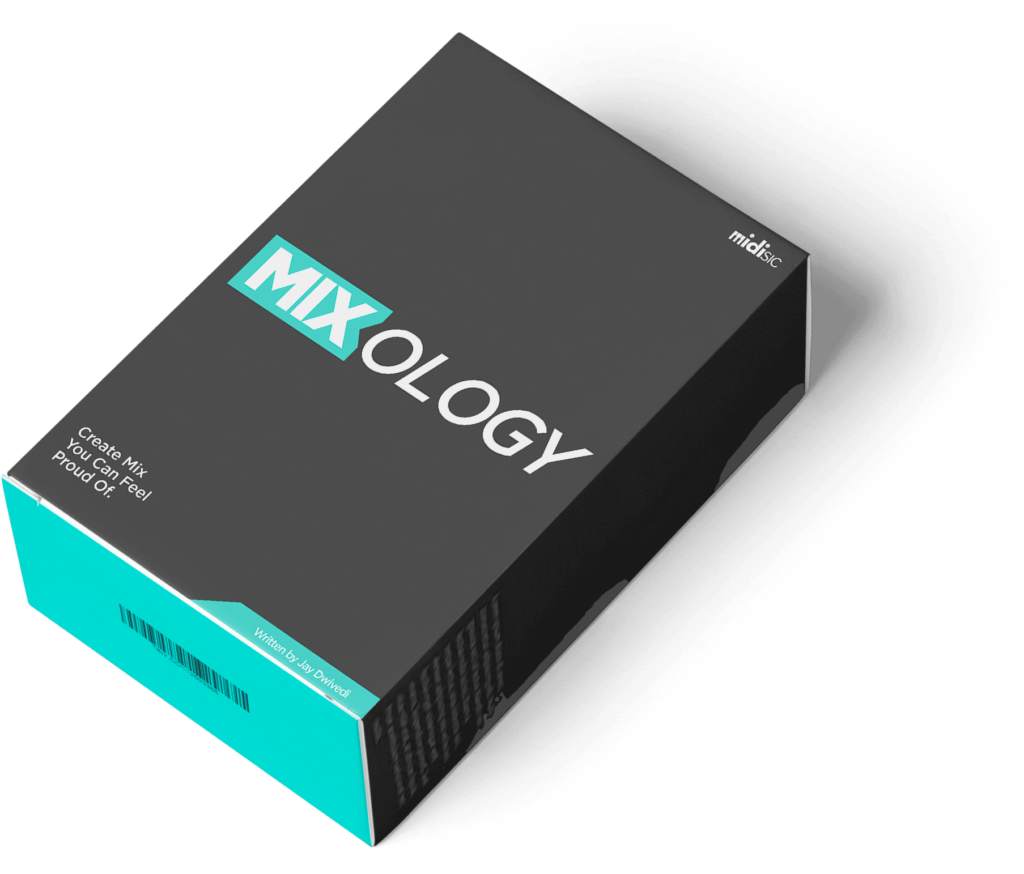
 Over 250+ Pages of Mixing Guide
Over 250+ Pages of Mixing Guide
